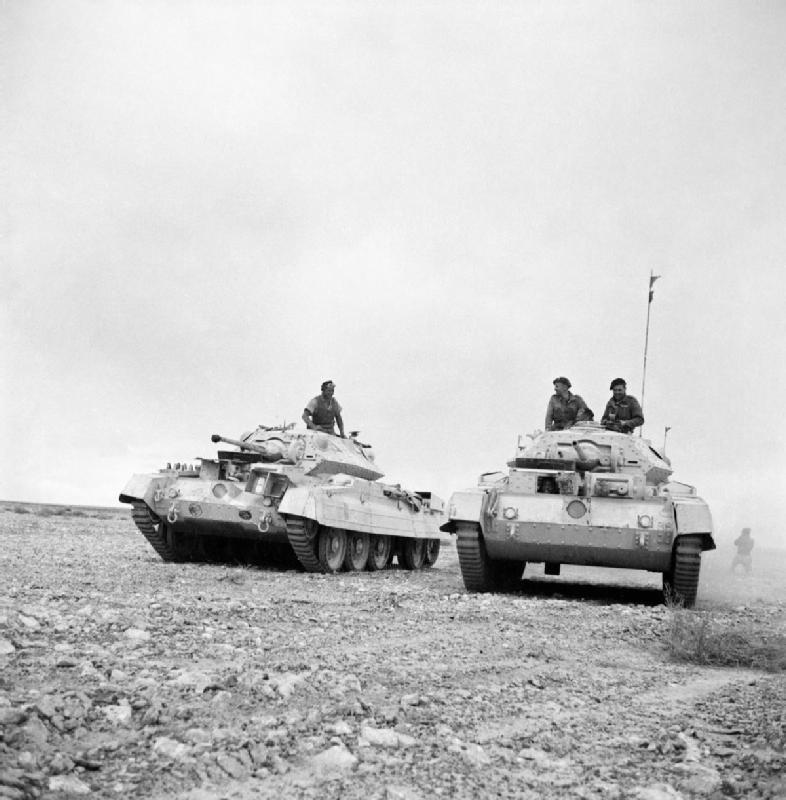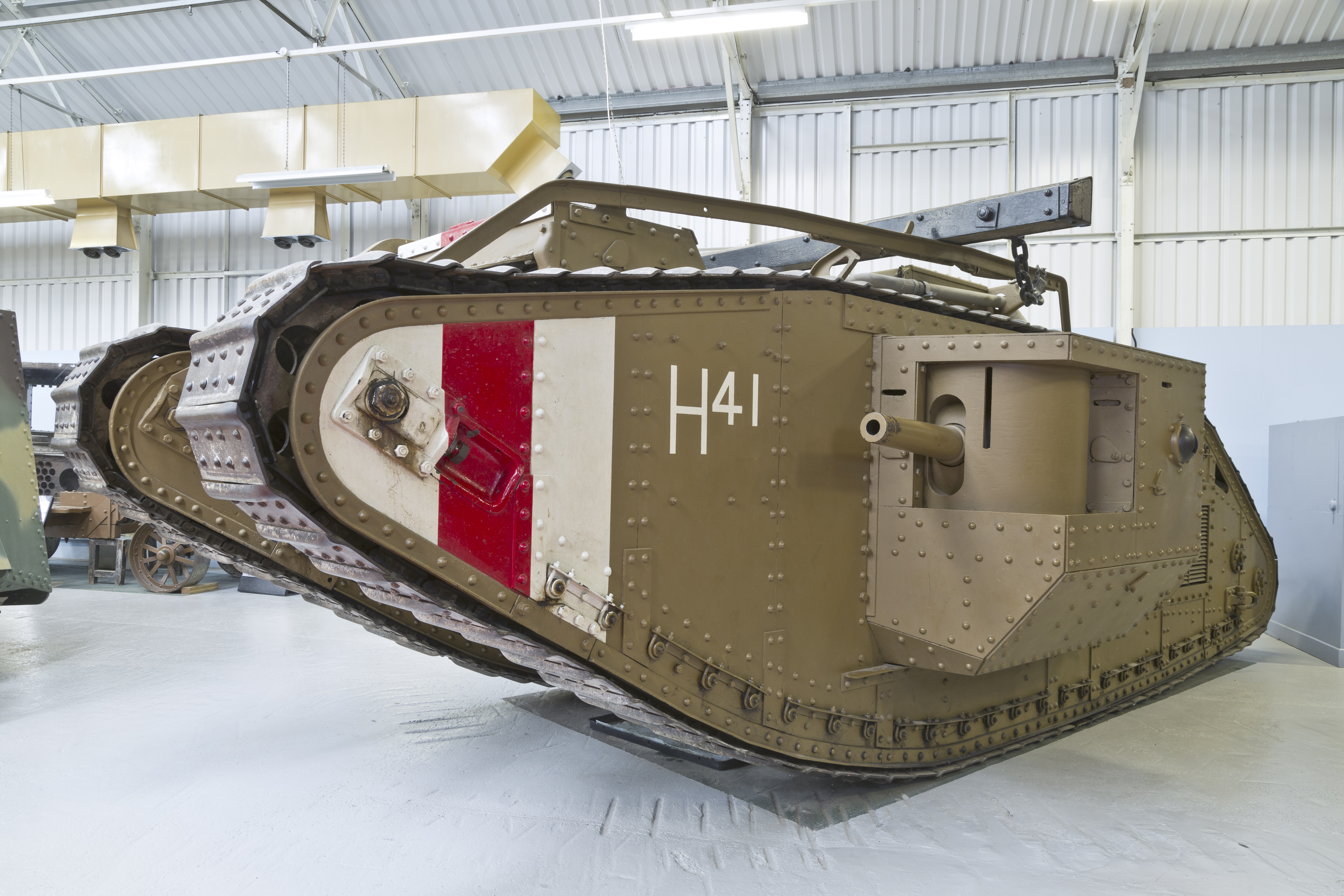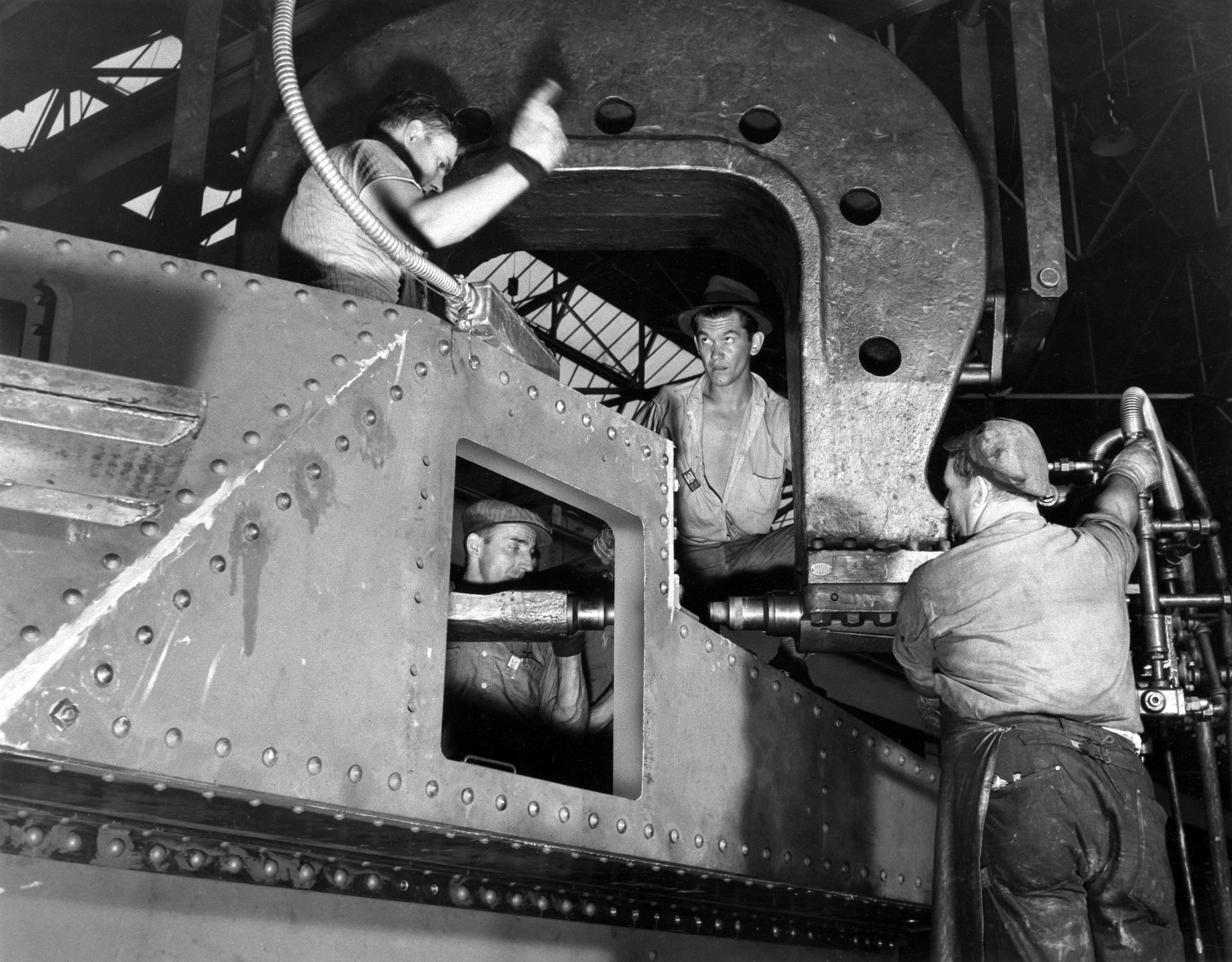|
Crusader Tank
Crusader, in full "Tank, Cruiser Mk VI, Crusader", also known by its General Staff number A.15, was one of the primary British cruiser tanks during the early part of the Second World War. Over 5,000 tanks were manufactured and they made important contributions to the British victories during the North African campaign. The Crusader tank would not see active service beyond Africa, but the chassis of the tank was modified to create anti-aircraft, fire support, observation, communication, bulldozer and recovery vehicle variants. The first Crusader Mark I tanks entered service in 1941, and, though manoeuvrable, it was relatively lightly armoured and under-armed. The following Crusader Mark II had a maximum armour of . The main armament for the Crusader Mark I and II's was a 40 mm Ordnance QF 2-pounder gun; the following Crusader Mark III was fitted with a 57 mm Ordnance QF 6-pounder gun at the expense of one member of the crew in the turret. This variant was more than ... [...More Info...] [...Related Items...] OR: [Wikipedia] [Google] [Baidu] |
The Tank Museum
The Tank Museum (previously The Bovington Tank Museum) is a collection of armoured fighting vehicles at Bovington Camp in Dorset, South West England. It is about north of the village of Wool and west of the major port of Poole. The collection traces the history of the tank. With almost 300 vehicles on exhibition from 26 countries it is the largest collection of tanks and the third largest collection of armoured vehicles in the world.The ''Musée des Blindés'' in France has a collection of 880 armoured vehicles, although it includes fewer tanks than Bovington. It includes Tiger 131, the only working example of a German Tiger I tank, and a British First World War Mark I, the world's oldest surviving combat tank. It is the museum of the Royal Tank Regiment and the Royal Armoured Corps and is a registered charity. History The writer Rudyard Kipling visited Bovington in 1923 and, after viewing the damaged tanks that had been salvaged at the end of the First World War, recommended ... [...More Info...] [...Related Items...] OR: [Wikipedia] [Google] [Baidu] |
Siege Of Tobruk
The siege of Tobruk lasted for 241 days in 1941, after Axis forces advanced through Cyrenaica from El Agheila in Operation Sonnenblume against Allied forces in Libya, during the Western Desert Campaign (1940–1943) of the Second World War. In late 1940, the Allies had defeated the Italian 10th Army during Operation Compass and trapped the remnants at Beda Fomm. During early 1941, much of the Western Desert Force (WDF) was sent to the Greek and Syrian campaigns. As German troops and Italian reinforcements reached Libya, only a skeleton Allied force remained, short of equipment and supplies. The defenders quickly became known as the Rats of Tobruk. Operation ''Sonnenblume'' forced the Allies into a retreat to the Egyptian border. A garrison, consisting mostly of the 9th Australian Division (Lieutenant-General Leslie Morshead) remained at Tobruk, to deny the port to the Axis, while the WDF reorganised and prepared a counter-offensive. The Axis siege of Tobruk began on 10 Apri ... [...More Info...] [...Related Items...] OR: [Wikipedia] [Google] [Baidu] |
M3 Stuart
The M3 Stuart/Light Tank M3, was an American light tank of World War II. An improved version of the tank entered service as the M5 in 1942 to be supplied to British and other Commonwealth forces under lend-lease prior to the entry of the U.S. into the war. Afterwards, it was used by U.S. and Allied forces until the end of the war. The British service name "Stuart" came from the American Civil War Confederate general J. E. B. Stuart and was used for both the M3 and the derivative M5 Light Tank. Unofficially, were also often called "Honeys" by the British, because of their smooth ride. In U.S. use, the tanks were officially known as "Light Tank M3" and "Light Tank M5". Stuarts were first used in combat in the North African campaign; about 170 were used by the British forces in Operation Crusader (18 November – 30 December 1941). Stuarts were the first American-crewed tanks in World War II to engage the enemy in tank versus tank combat when used in the Philippines in Decemb ... [...More Info...] [...Related Items...] OR: [Wikipedia] [Google] [Baidu] |
Cromwell Tank
The Cromwell tank, officially Tank, Cruiser, Mk VIII, Cromwell (A27M), was one of the series of cruiser tanks fielded by Britain in the Second World War. Named after the English Civil War-era military leader Oliver Cromwell, the Cromwell was the first tank put into service by the British to combine high speed from a powerful, reliable engine (the Rolls-Royce Meteor) and reasonable vehicle armour, armour. The intended dual-purpose high velocity gun could not be fitted in the turret, so a medium velocity dual purpose gun was fitted instead. Further development of the Cromwell combined with a high velocity gun led to the Comet tank. The name "Cromwell" was initially applied to three vehicles during development. Early Cromwell development led to the creation of the Cavalier tank, A24 Cavalier. Later Cromwell development led to the creation of the competing Tank, Cruiser, Mk VIII, Centaur (A27L) design. The Centaur tank was closely related to the Cromwell, both vehicles being externa ... [...More Info...] [...Related Items...] OR: [Wikipedia] [Google] [Baidu] |
Cavalier Tank
The Tank, Cruiser, Mk VII Cavalier (A24) was an interim design of British cruiser tank during the Second World War. It was derived from the A15 Crusader tank and was superseded by the A27 Cromwell tank. Development Early Development Development of the Cavalier initially started as development of the Cromwell tank. In mid-1940, the British were considering which tank should follow on from the new cruiser tanks then being developed. A specification was drawn up by the Directorate of Tanks and Transport which included the 57 mm QF 6 pounder gun. This led to General Staff specification A23 for a cruiser version of the A22 Churchill tank from Vauxhall, and A24 from Nuffield Mechanization & Aero Limited based upon their Crusader tank design. Birmingham Railway Carriage and Wagon Company (BRC&W) also submitted a design based on the Crusader. The Nuffield design used an uprated -- Liberty engine which was expected to give a top speed of . Armour would be from at the front, ... [...More Info...] [...Related Items...] OR: [Wikipedia] [Google] [Baidu] |
Gun Mantlet
A gun mantlet is an armour plate or shield attached to an armoured fighting vehicle's gun, protecting the opening through which the weapon's barrel projects from the hull or turret armour and, in many cases, ensuring the vulnerable warhead of a loaded shell does not protrude past the vehicle's armour. On many tanks during World War II, the gun mantlet covered both the main gun and any coaxial armament, and had the thickest armour on the vehicle. However, in many late Cold War and post-Cold War tank designs, the gun mantlet became one of the weaker parts of a vehicle's turret armour and thus a weakness. This was because as many mantlet designs were attached directly to the gun, it drastically increased the weight of the whole gun system and the amount of effort needed to elevate and depress it. This was an issue for gun stabilizers as they proved to be less efficient and accurate in keeping the gun steady with the added weight of the mantlet. Therefore, as seen in tanks such a ... [...More Info...] [...Related Items...] OR: [Wikipedia] [Google] [Baidu] |
Gun Turret
A gun turret (or simply turret) is a mounting platform from which weapons can be fired that affords protection, visibility and ability to turn and aim. A modern gun turret is generally a rotatable weapon mount that houses the crew or mechanism of a projectile-firing weapon and at the same time lets the weapon be aimed and fired in some degree of azimuth and elevation (cone of fire). Description Rotating gun turrets protect the weapon and its crew as they rotate. When this meaning of the word "turret" started being used at the beginning of the 1860s, turrets were normally cylindrical. Barbettes were an alternative to turrets; with a barbette the protection was fixed, and the weapon and crew were on a rotating platform inside the barbette. In the 1890s, armoured hoods (also known as "gun houses") were added to barbettes; these rotated with the platform (hence the term "hooded barbette"). By the early 20th Century, these hoods were known as turrets. Modern warships have gu ... [...More Info...] [...Related Items...] OR: [Wikipedia] [Google] [Baidu] |
Prototype
A prototype is an early sample, model, or release of a product built to test a concept or process. It is a term used in a variety of contexts, including semantics, design, electronics, and Software prototyping, software programming. A prototype is generally used to evaluate a new design to enhance precision by system analysts and users. Prototyping serves to provide specifications for a real, working system rather than a theoretical one. In some design workflow models, creating a prototype (a process sometimes called materialization) is the step between the Formal specification, formalization and the evaluation of an idea. A prototype can also mean a typical example of something such as in the use of the derivation 'prototypical'. This is a useful term in identifying objects, behaviours and concepts which are considered the accepted norm and is analogous with terms such as stereotypes and archetypes. The word ''wikt:prototype, prototype'' derives from the Greek language, Greek ... [...More Info...] [...Related Items...] OR: [Wikipedia] [Google] [Baidu] |
General Staff
A military staff or general staff (also referred to as army staff, navy staff, or air staff within the individual services) is a group of officers, enlisted and civilian staff who serve the commander of a division or other large military unit in their command and control role through planning, analysis, and information gathering, as well as by relaying, coordinating, and supervising the execution of their plans and orders, especially in case of multiple simultaneous and rapidly changing complex operations. They are organised into functional groups such as administration, logistics, operations, intelligence, training, etc. They provide multi-directional flow of information between a commanding officer, subordinate military units and other stakeholders.PK Mallick, 2011Staff System in the Indian Army: Time for Change Centre for Land Warfare Studies, New Delhi, vol 31. A centralised general staff results in tighter top-down control but requires larger staff at headquarters (HQ) ... [...More Info...] [...Related Items...] OR: [Wikipedia] [Google] [Baidu] |
Covenanter Tank
The Cruiser tank Mk V or A13 Mk III Covenanter was a British cruiser tank of the Second World War. The Covenanter was the first cruiser tank design to be given a name. Designed by the London, Midland and Scottish Railway as a better-armoured replacement for the Cruiser Mark IV, it was ordered into production in 1939 before pilot models were built. Problems with the design became apparent only after production was under way. The tank equipped various British armoured divisions for home defence and training. It never left the UK as poor engine cooling caused the Mk I to Mk III to be declared unfit for overseas service especially in hot climates. This was rectified in the Mk IV after many corrective actions were undertaken but, by February 1944, it was declared obsolete. More than 1,700 of the type were built. It was named after the Covenanters, a Scottish religious faction at the time of the Wars of the Three Kingdoms. Development In 1938, the War Office had issued a requireme ... [...More Info...] [...Related Items...] OR: [Wikipedia] [Google] [Baidu] |
M4 Sherman
} The M4 Sherman, officially Medium Tank, M4, was the most widely used medium tank by the Military history of the United States during World War II, United States and Allies of World War II, Western Allies in World War II. The M4 Sherman proved to be reliable, relatively cheap to produce, and available in great numbers. It was also the basis of several other Armoured_fighting_vehicle, armored fighting vehicles including self-propelled artillery, Tank_destroyer, tank destroyers, and Armoured_recovery_vehicle, armored recovery vehicles. Tens of thousands were distributed through the Lend-Lease program to the British Empire#Second World War, British Commonwealth and Soviet Union. The tank was named by the British after the American Civil War General William Tecumseh Sherman. The M4 Sherman evolved from the M3 Lee, M3 Medium Tank, which for speed of development had its main armament in a side sponson mount. The M4 retained much of the previous mechanical design, but moved the 75_mm ... [...More Info...] [...Related Items...] OR: [Wikipedia] [Google] [Baidu] |
M3 Lee
The M3 Lee, officially Medium Tank, M3, was an American medium tank used during World War II. The turret was produced in two forms, one for US needs and one modified to British requirements to place the radio next to the commander. In British Commonwealth service, the tank was called by two names: tanks employing US pattern turrets were called "Lee," named after Confederate general Robert E. Lee, while those with British pattern turrets were known as "Grant," named after Union general Ulysses S. Grant. Design commenced in July 1940, and the first M3s were operational in late 1941. The US Army needed a medium tank armed with a 75mm gun and, coupled with the United Kingdom's immediate demand for 3,650 medium tanks, the Lee began production by late 1940. The design was a compromise meant to produce a tank as soon as possible. The M3 had considerable firepower and good armor, but had serious drawbacks in its general design and shape, including a high silhouette, an archaic sponson ... [...More Info...] [...Related Items...] OR: [Wikipedia] [Google] [Baidu] |









_front-left_2017_Bovington.jpg)

